Herbie Hancock: An Analysis of His Improvisional Style (1/3)
Browse in the Library:
Or browse in the categories menus & download the Library Catalog PDF:
Jazz music is often described as a language; in the same sense, improvisation between members of a small ensemble is referred to as a conversation. Just as children learn to speak their native language by imitating older competent speakers, young musicians learn to speak jazz by imitating seasoned improvisers. Like any language, there is a bank of common vocabulary of phrases and phrase components which are shared among all jazz musicians, and which reflect the historical development of
the music.
Appearing on the scene at somewhat of a pivotal point in jazz’s history, Herbie Hancock reflects two sides of the coin – he demonstrates both a strong command of “traditional” jazz language, as well as a powerfully explorative, individual voice. This chapter investigates the first side of this coin; the fundamental melodic elements of Hancock’s style which reflect the wider jazz language.
In his book Elements of the Jazz Langauge (1991), Jerry Coker describes constructing a list of 18 devices he found through his research to be common among the solos of a wide range of jazz artists.
Chapter 1 of this study discusses a few of these devices – the ones that metaphorically “provide us with the less-important, but needed aspects of the language – words like “the”, “is”, “by”, “for”, “a”, “an”, etc.”19 In other words, it examines the essential building blocks of creating an improvisation in a jazz context.
Given Hancock’s uniquely individual style, these devices are often hard to find in their purest forms – they have a tendency to sound dated and cliché.
Change-running
Change-running is a jazz colloquialism for chord-arpeggiating. It is a technique frequently used among jazz musicians, as it strongly outlines the harmonic functionality of the chord or chord progression in question.

All three of the previous figures demonstrate Hancock’s use of change running, with similar phrases being found over similar progressions. In Figure 1.5, Hancock uses numerous examples of change running.

In this example, Hancock also performs a bar-line shift – a device which will be discussed shortly. This figure is also a classic example of a melodic sequence – a fundamental aspect of Hancock’s style examined in depth in Chapter 2.
Digital/Scalar Patterns
Digital patterns are cells of notes, usually numbering 4-8 notes per cell, that are named according to the numerical relationship of each note to the root of a chord/scale. Accordingly, a digital pattern of 1-2-3-5 in C major would be the notes C-D-E-G. Used in an improvisation, digital patterns
strongly outline the harmony of a chord and add solidity of structure to a solo.

John Coltrane used digital patterns extensively to solo through the challenging, fast moving chords in his composition “Giant Steps”:

Hancock also uses digital patterns, albeit sparingly. In Figure 1.8, Hancock plays a digital pattern of 1-2-3-5 (in A major) over the first two beats of the bar.
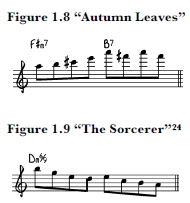
Similarly, in Figure 1.9 above, Hancock plays a descending digital pattern of 6-4-2-1, then 2-7-6.
In a similar sense to digital patterns, scalar patterns are simply patterns derived from a single scale. They are usually longer than digital patterns and use a primary intervallic shape, such as consecutive 3rds or 4ths. Hancock uses these extensively.

In Figure 1.10, Hancock takes an initial two-note motif of a third and ascends it through the Eb major scale. Scalar patterns of this nature have a tendency to sound formulaic; to avoid this Hancock alters the harmonic content of the scale from the middle of bar 3 onwards – a technique known as outside playing which is examined shortly. Hancock’s use of triplets within his melodic lines is also extensively examined in Chapter 2.
Hancock uses a similar pattern of descending thirds and fourths in Figure 1.11.

Figure 1.12 below also demonstrates a scalar pattern; Hancock descends the scale of B dorian using a motif of 3rds from bar 2 onwards.

This figure is also another classic example of a melodic sequence.
Resolution
The term 7-3 resolution refers to the musical resolution accompanying the melodic movement from the 7th of one chord to the 3rd of another. In jazz, this occurs at typical cadence points such as ii-V or V-I.

This type of movement is present through all eras of jazz improvisation, and can be foundfrequently in Hancock’s melodic lines.

In Figure 1.14, the 7th at the end of bar 1 resolves (via a grace note) into the 3rd of the C7 in bar The exact same movement occurs in Figure 1.15 below;

And again in Figure 1.16:

A 7-3 resolution often appears in conjunction with a device known as an enclosure, which will be discussed shortly.
3-b9
3-b9 refers to the melodic motion between the 3rd of a dominant seventh chord and the flattened 9th of the same chord. This is a typical occurrence in jazz improvisation, although its use dates back into classical antiquity:

The first beat of bar 2 of Figure 1.17 is a clear example of movement between the 3rd of the V7 of Dm and the b9, which resolves to the tonic triad in bar 3.

Herbie Hancock also uses this phrase in his solos, as seen in bar 2 of Figure 1.18. Figure 1.19 from the same solo demonstrates 3-b9 movement via two intermediate notes. He precedes both of these examples with a device known as CESH, which will be discussed shortly.

Hancock plays another simple 3-b9 in Figure 1.20, this time also voicing a third below the top melody note.

Bebop Scales
Bebop scales are common scales (mostly major, dorian or mixolydian) that have one specific chromatic (non-harmonic) tone added.
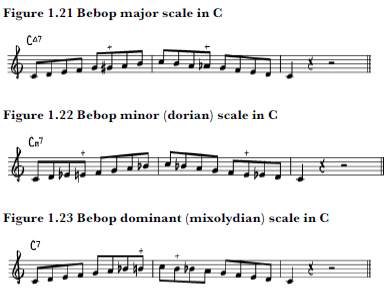
Hancock uses all permutations of the scale in a variety of different situations.

Hancock finishes the phrase in Figure 1.24 with an enclosure, a device which will be discussed shortly.

In Figure 1.25, Hancock plays a simple bebop minor scale phrase in bar 2. He uses a similar phrase in Figure 1.26, this time using the bebop dominant.

Enclosures
An enclosure is a melodic device in which a target note is approached chromatically by both an upper and lower tone.

In this example, Hancock encloses the A on beat 1 of bar 2 by preceding it with a semitone above, then below.

Similarly, in Figure 1.28, Hancock plays a scalar line before enclosing the Ab in bar 2.

Figure 1.29 shows Hancock enclose the D in bar 2 by a semitone above, then two consecutive semitones below.

Hancock uses three quick-fire enclosures in Figure 1.30 above, the first landing on the 5th of the Ebmaj7 in bar 2, the second landing on the third of the Ebmaj7, and the last landing on the 5th of the Gm7 in bar 3.
CESH
Pronounced “Kesh”, this terminology comes from the initials of a device called Contrapuntal Elaboration of Static Harmony. It comes in two primary forms, demonstrated below – note the principal of each example applies to both major and minor tonalities.

In Figure 1.31, the tonic note descends chromatically while the other chord tones remain static.

Similarly in Figure 1.32, the fifth of the chord ascends chromatically while the other chord tones remain static.
Hancock makes extensive use of the first form of CESH in his melodic lines, as seen in both Figure 1.33 and Figure 1.34 below.
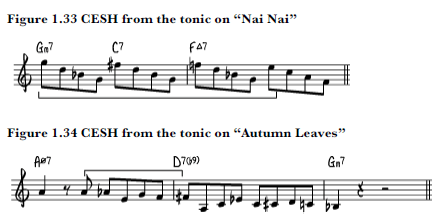
Tri-tone Substitution
Tri-tone substitution is the common practice among jazz musicians of substituting a chord (especially a dominant seventh) for a chord of the same type whose root is a tri-tone (augmented fourth) away from the given chord. The process works because the guide tones (3rd and 7th of the chord) stay the same (only in reverse), with the equivalent harmony giving an altered sound. Hancock uses this device frequently, as seen is Figure 1.35 below.

In this example, Hancock uses tri-tone substitution to reharmonize the F7 to B7, before resolving the line in bar 2. A few bars later, Hancock plays Figure 1.36 and uses the device again to change the Gm7 to a Db7 – pre-empting the Cm7 in the third bar by preceding it with its V7altered (Db7 shares the same scale as G7alt).

Later in the same solo, Hancock plays Figure 1.37, clearly spelling out an Ab major tonality over the D7altered.

Similarly, in Figure 1.38, Hancock clearly plays Bb7 (Bb mixolydian), instead of the given E7.
Harmonic Generalization/Superimposition
Harmonic generalization occurs when an improviser chooses one scale to accommodate two or more chords of a progression. Hancock does this frequently, as seen in Figure 1.39 below.

Here, Hancock superimposes a Bb altered scale over the Gm7 chord, treating the whole iii-bIIIii-V-I progression as the V7altered of the Eb7.
Similarly, in Figure 1.40 below, Hancock generalizes the complicated harmony to two basic scales, the first being Fmajor (or D dorian), and the second essentially Dbm. He then resolves the line in the final bar by playing an enclosure into the third of the Fmajor7 chord.

The opposite of generalization, harmonic superimposition, occurs when the soloist imposes their own alterations over the harmony. This mostly occurs over longer chord changes, as seen in Figure 1.41 below.

Here, Hancock continues the Gm7 chord into the 3rd bar, and then implies G# aeolian (G#m7 or Abm7) over the Dm7 and Bbm7, which lasts from the middle of bar 3 until the end of the phrase, when he implies a resolution back to G dorian (Gm7).
Bar-line Shifts
Bar-line shifts occur when the improviser intentionally arrives at a given chord earlier or later than its specified placement.

In Figure 1.42, Hancock anticipates the change of chord to Db7(#11) by nearly and entire bar.

Similarly, in Figure 1.43, Hancock anticipates the change to D7alt by 2 beats. Bar-line shifting is also often be strongly related to harmonic generalization, as is Figure 1.44.

In Figure 1.44, Hancock stretches the Bbm7 out for another bar and half, before switching to Gbmaj7 – he ignores the Gm7 in bar 3 completely.

Similarly, here, Hancock stretches the initial Fmaj7 chord out for nearly 2 bars, and then anticipates the Dbm7 in bar 4 by 5 beats, before resolving the line in bar 5.
Side-slipping
Side-slipping is similar to harmonic superimposition, in that it involves superimposing an alternate chord or chord progression over the fundamental harmony of a song; however, side-slipping generally refers to cases where the superimposed chord or progression is a semi-tone away from the original.
In Figure 1.46, Hancock superimposes a Bm7-E7 over the usual two bars of Bbmaj7, setting up a II-V progression into the subsequent Am7.

Similarly, in Figure 1.47, Hancock plays two side-slips in a short space of time; the first in bar 2 replaces the pre-existing Cm7 with a Dbm7, and the second in bar 6 replaces Fm7 with Gbm7. Each time, the side-slip resolves back to the original chord.

Chromaticism/Outside playing
As the title implies, chromaticism involves simply playing highly chromatic lines through chord changes – which results in not all of the notes in a phrase specifically fitting any appropriate chord scale; the soloist is instead playing in the key of “chromatic”.
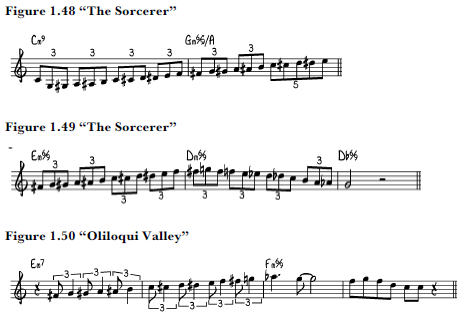
All three of the above figures demonstrate Hancock’s use of chromaticism which temporarily disregards the fundamental harmonic progression.

Similarly, in Figure 1.51, Hancock plays a long, chromatically descending line over the underlying shifts in harmony.
Chromaticism is closely related to outside playing – which refers to when a soloist intentionally plays notes that are “wrong” – that is, they play melodic lines which do not conform strictly to the set harmonic progression or associated chord scales. In these situations it is the structural integrity of the melodic line which makes it sound “right”. Hancock uses this device frequently.

In Figure 1.52, Hancock briefly ventures outside twice within a short period of time. At the end of bar 1, Hancock plays a digital pattern of 1-2-3-5 in E major, which takes him briefly outside the Gm7 chord. Hancock resolves the line in the second bar, then uses a tri-tone substitution over the C7 before hinting briefly at another outside phrase and then once again resolving the line in bar 3.

In Figure 1.52, Hancock briefly ventures outside twice within a short period of time. At the end of bar 1, Hancock plays a digital pattern of 1-2-3-5 in E major, which takes him briefly outside the Gm7 chord. Hancock resolves the line in the second bar, then uses a tri-tone substitution over the C7 before hinting briefly at another outside phrase and then once again resolving the line in bar 3.
Phrasing
Phrasing is the manner in which a soloist groups their melodic lines; it is a way of describing a line’s shape and nature, whereas all of the elements discussed previously examine the line’s content.
Hancock’s phrasing is strongly reminiscent of that of his instrumental predecessors, in particular that of Bobby Timmons and Oscar Peterson.
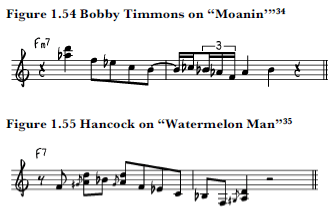
Both Figure 1.54 and Figure 1.55 involve blues-orientated material typical of the hard-bop era, and each phrase is of a similar length and nature.

Both Figure 1.56 and 1.57 start with two short phrases of similar length before concluding with a longer line.
In summary, Hancock draws extensively from the bank of language and musical devices shared among jazz musicians across generations. However, Hancock also imparts his own unique style onto this language, through his adoption and use of a range of personal melodic concepts and musical devices, or signature characteristics.
Herbie Hancock – Live in Concert 2006
● Tracklist: 1. Actual Proof 2. Watermelon Man 3. Stitched Up 4. Maiden Voyage 5. Virgin Forest 6. Cantaloupe Island 7. Chameleon
● Personnel: Herbie Hancock – piano, keyboards Lionel Loueke – guitar, vocals Nathan East – bass, vocals Vinnie Colaiuta – drums
● Herbie Hancock – Live in Concert 2006
Jazz sheet music and transcriptions download.

References
Berliner, P. F. (1994). Thinking in Jazz: The Infinite Art of Improvisation. Chicago: The University of
Chicago Press, Ltd.
Blumenthal, B. (2000). Pianists of the 1960s and 1970s. The Oxford Companion to Jazz, 466-467.
Cambridge Dictionaries Online. Taxonomy. Retrieved 31 May, 2011
Coker, J. (1991). Elements of the Jazz Language for the Developing Improvisor. Miami: Belwin, Inc.
Coolman, T. F. (1997). The Miles Davis Quintet of the mid-1960’s: Synthesis of Improvisational and Compositional
Elements. New York University.
Coolman, T. F. (2006). Herbie Hancock & the Miles Davis Rhythm Section. Piano Today(26.1), 30-31.
Davis, M., & Troupe, Q. (1989). Miles – The Autobiography. New York: Simon & Schuster.
DiMartino, D. (1999). Herbie Hancock : He Continues to Lead Where Most Other Artists Are Content
to Follow. Billboard – The International Newsweekly of Music, Video and Home Entertainment, 111, 2-12.
Dobbins, B. (1992). Herbie Hancock Classic Jazz Compositions and Piano Solos. Rottenberg: Advance Music.
Gelfand, A. (2005). Almost Anything Goes: For Herbie Hancock, Jazz is All About Freedom and
Personal Expression. JAZZIZ, 22, 36-38.
Heinrich, D. (2006). Jimmy Smith and Larry Young – Blue Note Records’ Jazz Organ Masters: A Comparison of
Style. Unpublished honours thesis, Sydney Conservatorium of Music.
Johnson-Laird, P. N. (2002). How Jazz Musicians Improvise. Music Perception: An Interdisciplinary Journal,
19(3).
Kart, L. (2000). The Avant-Garde, 1949-1967. The Oxford Companion to Jazz, 446-458.
Levin, E. (1987, January 19). Herbie Hancock. People, 27, 64.
Levine, M. (1989). The Jazz Piano Book. Petaluma, CA.: Sher Music Co.
Levine, M. (1995). The Jazz Theory Book. Petaluma, CA.: Sher Music Co.
Opstad, J. (2009). The Harmonic and Rhythmic Language of Herbie Hancock’s 1970s Fender Rhodes
Solos. Jazz Perepectives, 3(1), 57-79.
Perry, J. C. (2006). A comparative analysis of selected piano solos by Red Garland, Bill Evans, Wynton Kelly and
Herbie Hancock from their recordings with the Miles Davis groups, 1955–1968. University of Miami.
Pond, S. F. (2005). Head Hunters: The Making of Jazz’s First Platinum Album: University of Michigan Press.
Rose, J. (2006). White Light, Black Vibrations: The Music of John Coltrane and his Spiritual Quest. Unpublished
honours thesis, Sydney Conservatorium of Music.
Sawyer, R. K. (2000). Improvisation and the Creative Process: Dewey, Collingwood, and the Aesthetics
of Spontaneity. The Journal of Aesthetics and Art Criticism, 58(2), 149-161.
Seymour, G. (2000). Hard Bop. The Oxford Companion to Jazz, 373-388.
Silvert, C. (September 8, 1977). Herbie Hancock: Revamping the Past, Creating the Future. Down Beat,
16.
Szwed, J. (2002). So What: The Life of Miles Davis. New York: Simon & Schuster.
Thompson, S., & Lehmann, A. C. (2004). Strategies for Sight Reading and Improvising Music. New York:
Oxford University Press.
Wallmann, J. P. (2010). The Music of Herbie Hancock: Composition and Improvisation in the Blue Note years. New
York University.
Waters, K. (2005). Modes, Scales, Functional Harmony, and Nonfunctional Harmony in the
Compositions of Herbie Hancock. Journal of Music Theory, 49(No. 2), 333-357.
Waters, K. (2011). The Studio Recordings of the Miles Davis Quintet, 1965-1968. New York: Oxford
University Press.
Widenhofer, S. B. (1988). Bill Evans: An Analytical Study of His Improvisational Style Through Selected
Transcriptions. University of Northern Colorado.
Woodard, J. (1997). Hancock and Shorter: Two Divided By One. JazzTimes – America’s Jazz Magazine,
27, 44-47, 57, 144-145.
